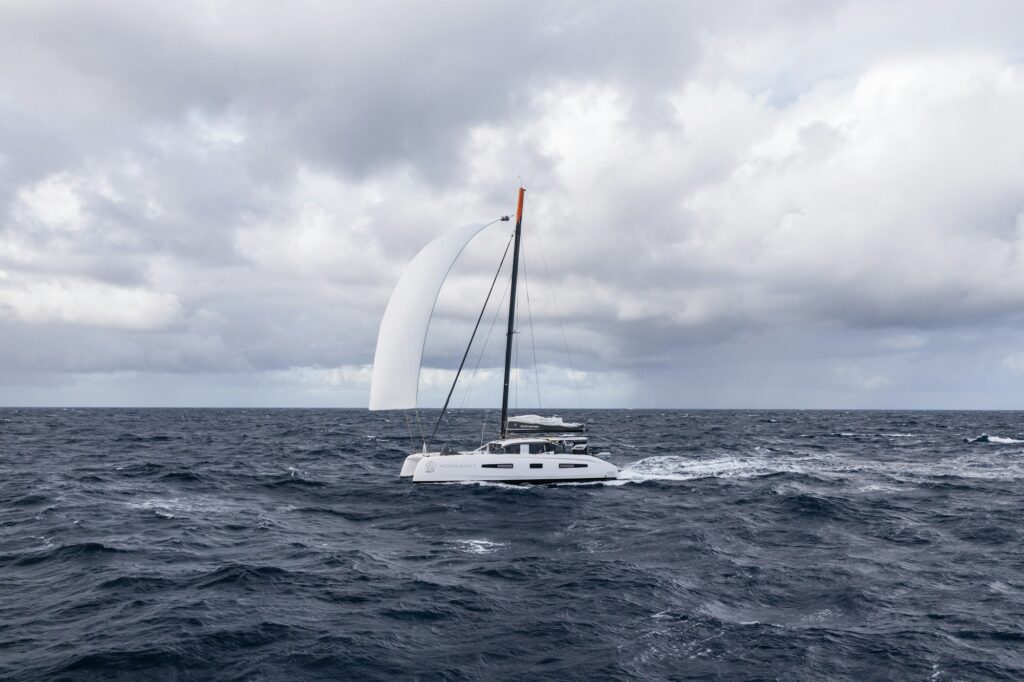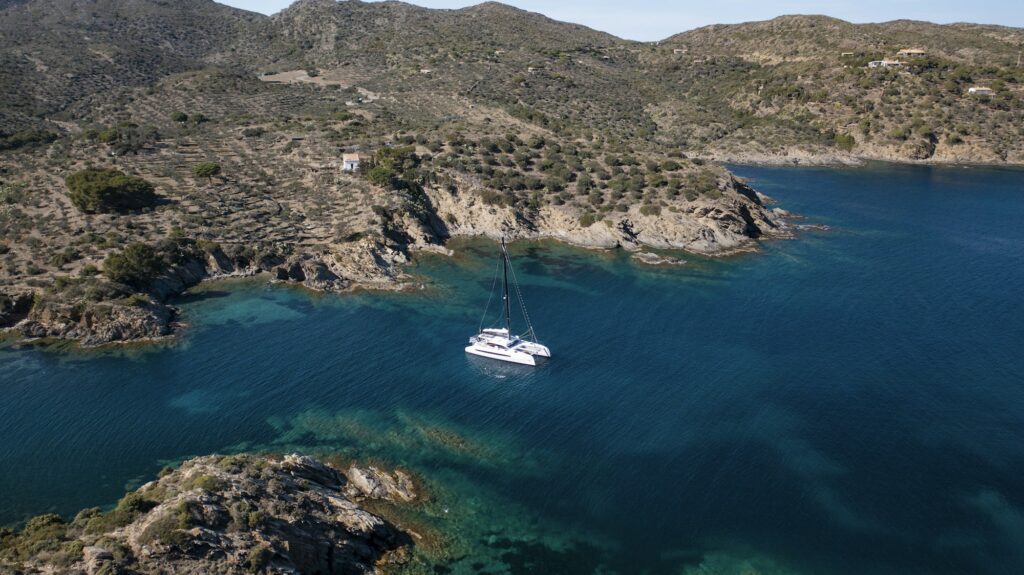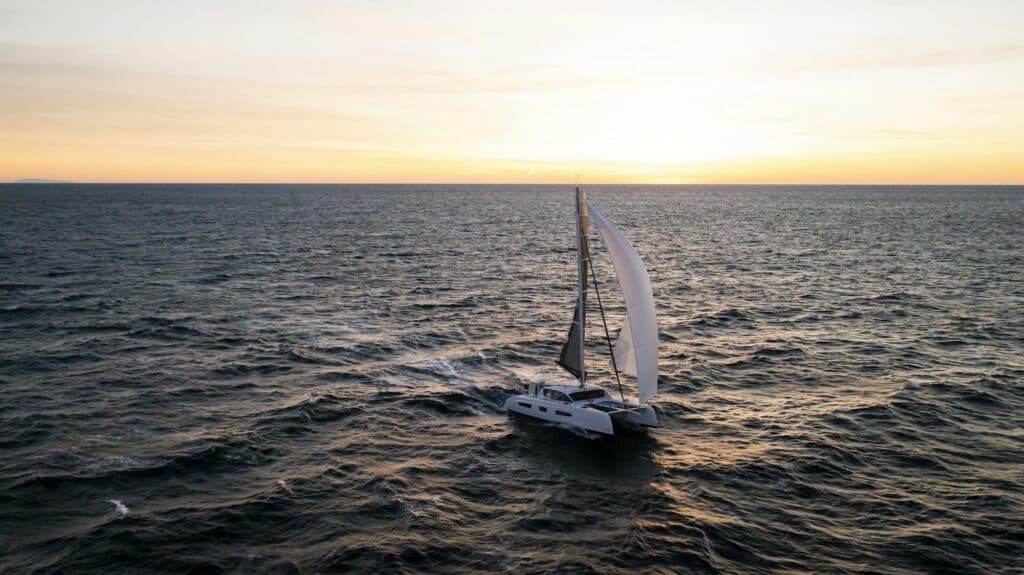Author : Nikki Henderson
Which sails to buy for your Outremer can be a very difficult decision. For some, this is a steep learning curve. Many cruisers haven’t used anything more elaborate than white sails (main sail + jib/genoa). Others in the Outremer family come from the monohull world, or perhaps have grown up dinghy sailing. They may have a good understanding of sails, but still are often unsure whether their experience is directly applicable to an Outremer.

Buying sails is one of the only major parts of the build process. I’m often asked what brand I recommend. I tend to think that it is good to keep the choice close to home. If Outremer recommend a product, then I’d say you need to have a very convincing reason to go against their recommendation. If you have a close personal relationship with another loft, then that could be a good reason to source your sails elsewhere. But, in terms of quality, I’d say the average cruiser would not be able to spot the difference between two identically sized sails made from the same material but built different lofts. Perhaps the time to shop around would be if you are buying a racing wardrobe later down the line.
Here is a breakdown of the standard sails that people choose from, from what I can gather:
Mainsail Choices for Blue Water Cruising
As standard the mainsail comes with three reefing points. This is essential for any blue water performance cruiser. The only real choice people make with this sail is whether to go for a woven cloth – the best being Hydranet (white/very light grey), or a slightly more expensive and lighter weight carbon laminate (the dark grey / black sails). I wouldn’t recommend investing in laminate sails for blue water cruising. The only exception would be if you are seriously optimising the performance of rest of the boat – minimising weight – and sailing with experienced crew who trim and helm actively. You also might want to consider laminate sails as a second sail wardrobe for racing.
One thing I’d recommend investigating, is whether the leech line can be run up the leech and down the luff so that you can control it at the mast. Wandering to the end of the boom to sort it can feel very unsafe at sea.
Selecting the Right Jib for your catamaran
Most Outremer owners choose a jib as their head sail. A jib is a head sail (sail at the front) that does not overlap the mast and therefore can use the self-tacking track. It’s a great all rounder headsail for crews that aren’t particularly experienced and have less interest in teasing out that extra 0.5 knots. It’s a great ‘starter sail’ for any sailor buying an Outremer. Buy it and figure out your boat for a year, and then possibly upgrade… see below for more details on what you would need to plan in advance.
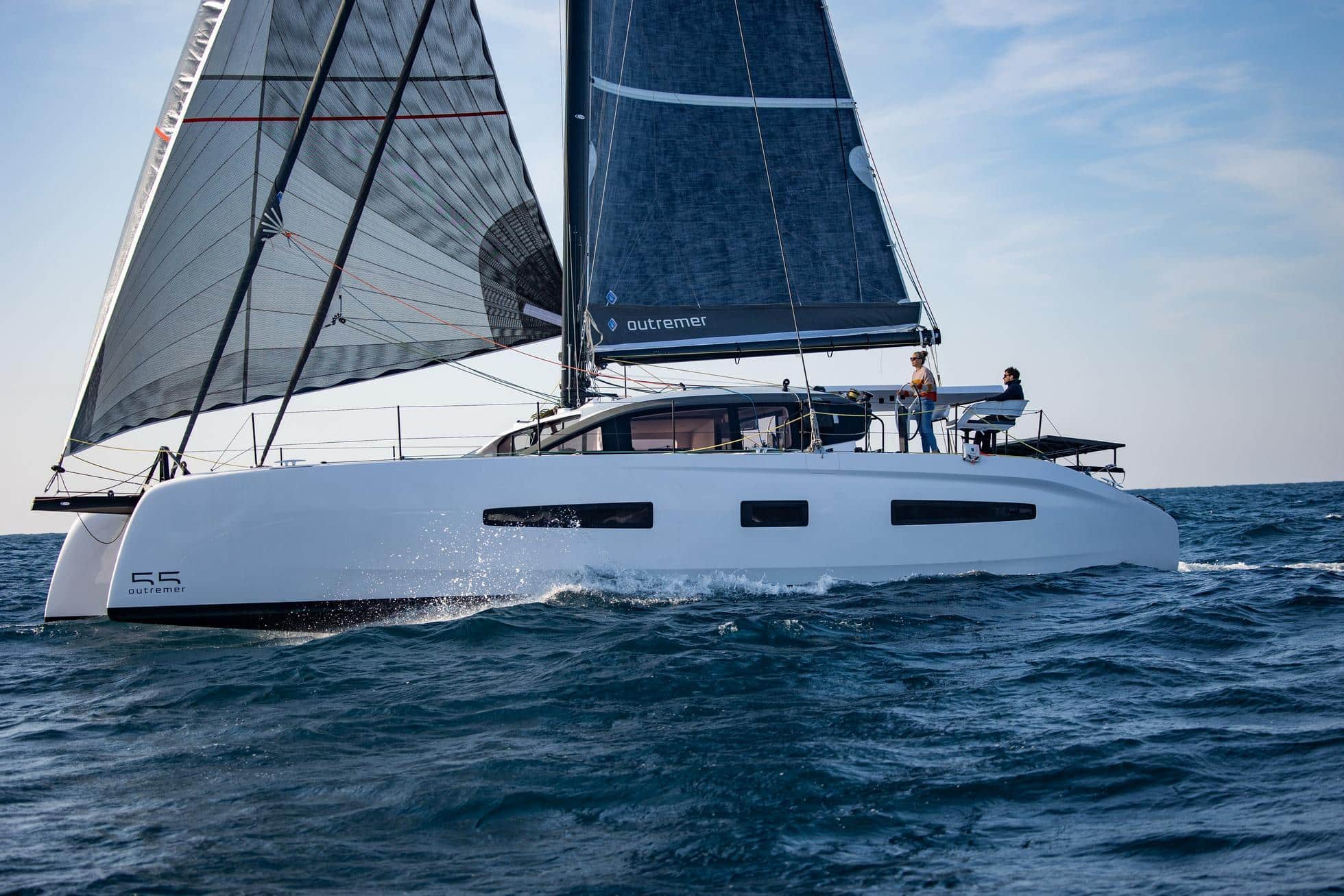
Genoa Sails: Maximizing Upwind Performance
This is a headsail that overlaps the mast. Therefore, it is bigger than the jib and does not use the self-tacking track. As you need to tack it manually from one side to the other with the sheets, it is more physically demanding than the jib. It has a barber hauler permanently set up, as well as an out hauler, so there are more fine-tuning adjustment options than the jib. It’s great for the enthusiastic sailors – perhaps dinghy sailors or keen racers – who love constantly trimming the sails. Its size gives that extra bit of upwind power in lighter winds. But the down-side is that it doesn’t set very well furled, and is too big to use in heavier winds. In heavier winds you would need to put up a different sail (stay sail, different jib, or storm sail).
Stay Sail for Heavy Weather: Essential for Storm Sailing
A stay sail is designed to fly off an inner forestay. This is an optional extra (not on the 45) and will require a carbon cross beam. It adds tens of thousands of euros to the price. It is a very small headsail and looks like a mini jib, with a low clew and a short foot (a bit like a knife blade). It typically is partnered with a genoa. Sometimes the stay sail is referred to as the ‘heavy weather headsail’; dropping the jib or genoa and flying the staysail is a very safe set up in a storm as it brings the centre of effort down and inboard and reduces weight aloft (so lower risk of capsize). In more moderate reaching conditions, the stay sail flies well at the same time as a spinnaker. Most staysails run up the inner forestay on hanks, and so setting it up requires significantly more physical effort than unfurling a jib. There is no point opting for a stay sail unless you are keen for sail changes and an active passage life. If you are on the fence on whether to get a stay sail, but you are enthusiastic and active sailors, I’d recommend going for it as the versatility is such a bonus. Ultimately, you can fit the inner forestay but tie it back away from the foredeck and just fly the self-tacking jib for the first few years.
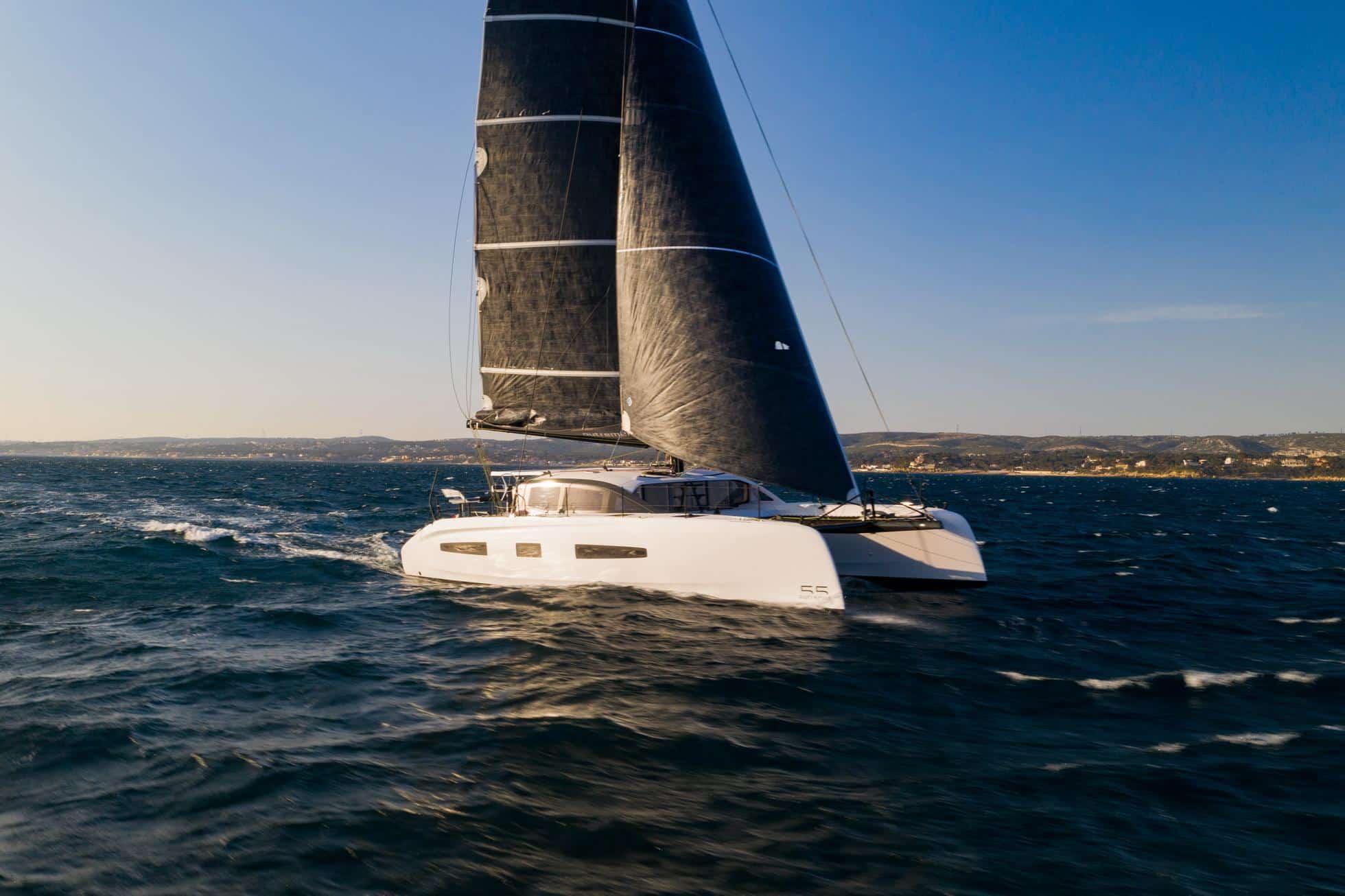
Code 0 Sails: Unlocking Light Wind Performance
The Code 0 is a light wind sail. It is almost the same shape as a genoa, but with broader shoulders and a higher clew. It is ‘loose luffed’ meaning it does not run up the forestay but flies off the end of the bow sprit, hoisted up on a 2:1 fractional (not to the top of the mast) halyard. It is a laminate sail, and very light weight. As opposed to a spinnaker, it is quite flat and so is most efficient between approximately 60 true wind angle (TWA) and 100 TWA and any wind strength less than 15 knots apparent. For beginners, I tend to call it ‘the upwind spinnaker’. It is a good sail for those keen to sail in light winds and run a ‘greener’ boat. In under 5 knots of true wind, it’s probably the only thing that can get you moving. As the Code 0 has a limited wind range both in angle and in strength, it’s better suited for the more enthusiastic sailor who enjoys changing sails because typically it only stays flying a few hours maximum before the wind picks up.
Code D: Performance in Light Winds
Think of this as a ‘starter-spinnaker’. It’s a brilliant option for anyone who has not got any experience with spinnakers. It’s easiest understood as a furling asymmetric spinnaker that’s been on a diet! It’s perfect if you are looking for just one spinnaker that is easy to operate short-handed. The fact that it furls really negates the stress that spinnakers often are associated with – mainly the stress of hoisting and dropping them. The upside is that it’s convenient and user friendly. The downside is that the way it furls affects its shape. If you were to compare it to a true Asymmetric spinnaker it’s smaller, flatter and has a much shorter luff. It won’t power you along as fast or as deep (more downwind) as an asymmetric spinnaker. But again, for most beginner cruisers this is going to be a completely adequate downwind sail to start with.
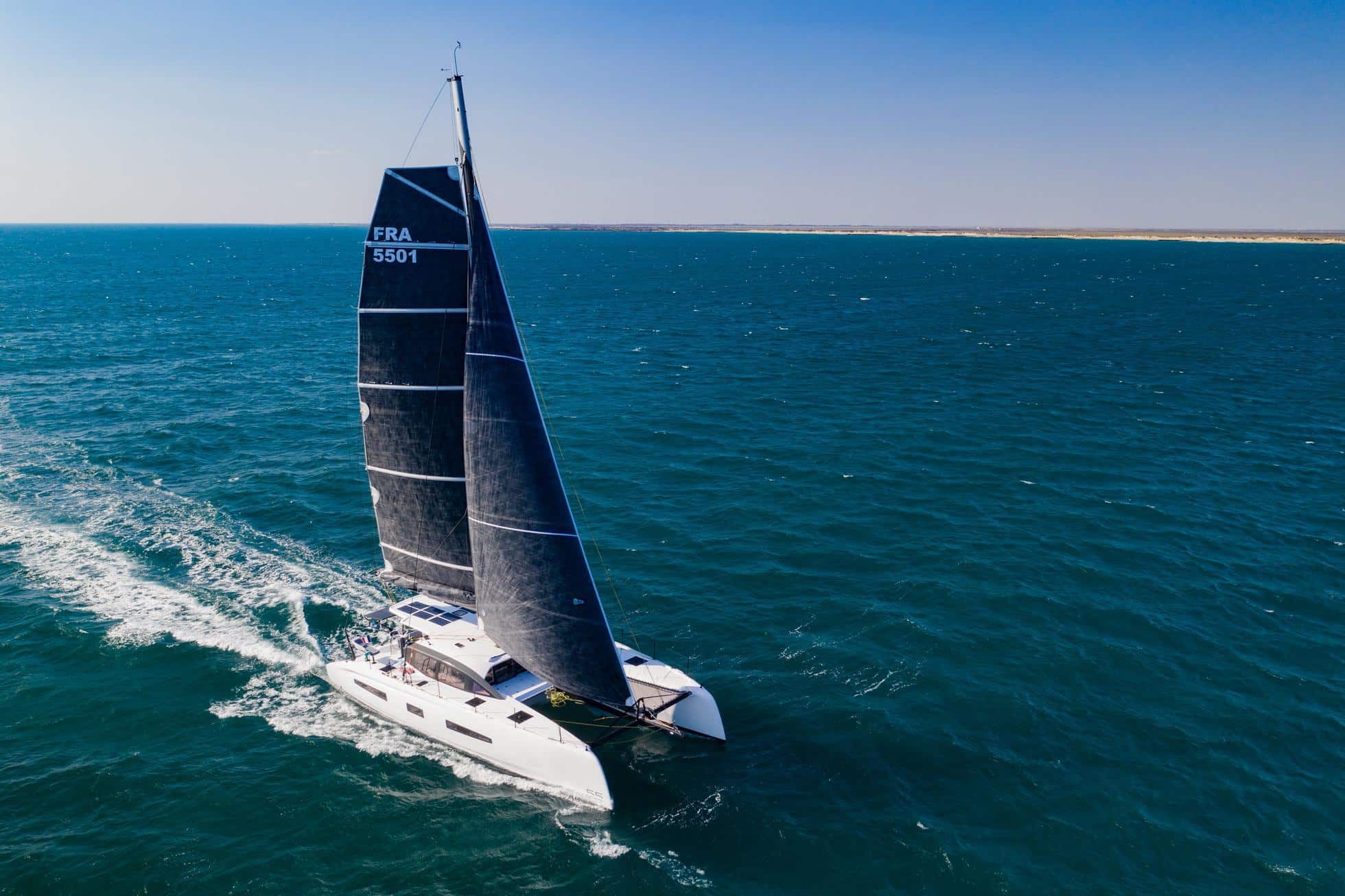
Asymmetric Spinnakers: Advanced Downwind Sailing
An asymmetric (a-sym) spinnaker is like an enormous broad-shouldered genoa made of tissue paper. Where a genoa’s clew reaches perhaps 1 meter aft of the mast, the a-sym’s clew can be pulled as far back as the helming chairs. The size says it all; it’s a powerful sail. With an experienced crew, it’s great fun and exactly what the Outremers are designed to fly. With twenty knots of wind and a 130-degree true wind angle these will get an Outremer averaging boat speed in the high teens. The flat sea outside La Grande Motte is perfect for this. But blue water sailing in a force 5 is a different story, and the sea state and large acceleration will make for challenging helming. I wouldn’t recommend investing in an asymmetric spinnaker unless you have an able crew who are keen to sail fast angles, push the boat and sacrifice a lot of comfort in return. For most owners, I’d suggest getting to know your boat and sailing perhaps 10,000 miles before investing in an asymmetric spinnaker.
It’s also worth considering – in this department – a top down furler. This is a relatively new idea in the short handed sailing world, but one that is enabling double handed crews to sail big sails downwind. It’s early days in their innovation and so take note that they can be a bit temperamental and you should still understand how to drop the spinnaker without furling it in the traditional way.
Symmetric Spinnaker: Deep Downwind Sailing Essentials
A symmetric spinnaker looks like a big bell made out of tissue paper. It’s almost like two upside down genoas stuck together by their luffs, with very high clews and big broad shoulders. It is designed to sail very deep downwind. If you gybe a spinnaker on an Outremer, you don’t really need to do anything to the sheets. They run symmetrically: both port and starboard sheets feed through the blocks at the very front of each hull and then back through a block and to a winch. For trade wind sailing, with the wind and the waves almost square behind you, investing in a heavy weight symmetric spinnaker is a good idea. Some people opt for a parasailer – which is a symmetric spinnaker with what looks like an enormous hole in it. I don’t think they are worth the investment (they tend to come up at almost double the price of a standard symmetric spinnaker). They are designed to reduce yawing, which isn’t such a huge problem in a multihull as it is in a monohull.

To go further :
For further guidance on sail choice, take a look at this extract of an article I recently wrote for Yachting World:
I encourage anyone to ask themselves the following questions, when considering their sail plan:
- What is your route plan?
Trade wind sailing will be predominantly downwind. So, focus your attention on downwind sails.
A route involving more upwind requires more focus on the headsails, in addition to the downwind sail options. Routes involving more upwind tend to be more coastal routes, or schedules with strict timings that will reduce the option to wait for downwind weather windows.
All blue-water plans will need storm options. 3 reef points in the main is a must, or at the very least an extremely generous second reef. A storm headsail is another key component. Ideally it should be possible to hoist the storm jib up over the top of your furled foresail. In very big conditions, the reliance on the thin furling line gets quite nerve-racking.
- How performance orientated are you?
Imagine a sort of sail choice flow diagram. This is the next box.
Trade wind sailing:
Performance catamarans are designed to sail angles. Ideally they should sail with an a-symmetric spinnaker wardrobe. However, there is a cost to the incredible speeds that you reach when reaching on these boats: comfort. So, the key question is what’s your attitude?
Examples of performance focused sailors are racing sailors, sailors without kids, or sailors who are in good physical shape. If you fit this category, then I’d advise purchase one heavy weather flatter a-symetric sail that can withstand a squall up to 40 knots, and a rounder light weight one that you can sail quite deeply in light to moderate conditions.
If you bought a production catamaran, or you are a performance catamaran owner who does not have a taste or attention span for speed, then one heavy weather symmetric spinnaker (~40 knots TWS) should be enough. This will allow you to sail a rhumb line course, and make night-time take downs less of a worry because the kite will survive a squall.
Upwind routes:
If you will enjoy fine tuning your boat to get that half a knot extra upwind, your ideal option is a large genoa for drive in light-mod conditions, and a small flat blade shaped jib for heavier conditions – small enough that it does not need to be furled to an inch of its life to cope with a F6. If an inner forestay is an option, the latter could be a stay sail which will keep the centre of effort low and reduce sideways drift.
For anyone less performance orientated, the key for upwind sailing is a strong flat jib that is not too big. Mark three reef points on the foot with sail tape. Keep an eye on how much it stretches and don’t be surprised if you need to change it every few years to avoid losing 5-10 degrees of height.
Don’t forget the need for downwind sails as well. The trade-wind route logic applies. Performance sailors should invest in asymmetric and non-performance sailors/boats should invest in symmetric.
- What is the crew make-up?
At this point, the conversation often circles back round. We get enthusiastic about the performance plan, and then remember that the kids will need home schooling, or retirement is on the horizon and so are potential health and fitness considerations.
Most sail changes will require more than one person. Sometimes conditions at the bow can be bouncy. All of the crew will have to sleep, cook, clean, and ‘relax’ on the boat whilst it is thrown and banged about as if it were crowd surfing in a heavy metal concert.
If you are light handed, you could compromise for downwind sailing by choosing furling sails. A furling a-symmetric such as a Code-D can replace the hoist and drop asymmetric. Or make the sock line on the symmetric long enough to route back to an electric winch.
Upwind sailors could compromise by returning to the one jib plan and consider altering the routing to sail slightly off the wind but faster; optimise for VMG. Another idea if you have a stay sail, is to ensure it could be furled as well and therefore left rigged at sea. Make time to speak to the yacht designer about the impact in the stability that having two heavy furled sails up continuously has on the boat.
- How ‘eco’ conscious and time conscious will you be?
Do you care about motoring? Increasingly for many of us, the awareness of climate change and sense of responsibility to be a steward for the environment is a strong enough motivator to avoid using the engine.
Secondly, will you be more focused on the destination or more interested in the journey?
If you are keen to avoid motoring, and you are free of time constraints such as fixed crew changeovers or grumpy children of adults onboard who need a swim, then I’d recommend you invest in a Code-0. A Code-0 can double or even triple the boat speed. In 6 knots of wind, an Outremer will sail at 2-3 knots with a jib, but 5-6 knots with a Code-0.
It’s a great sail and worth the investment, but first work out if you will use it. They often have low wind limits – around 15 AWS – which upwind could be 10 knots TWS.

